A Chelsea–Tottenham rivalry was played at Stamford Bridge as the first Premier League match of the weekend. Frank Lampard faced his former manager José Mourinho, and after 90 minutes of battle, the Blues took all three points to extend their advantage over Spurs to four points on the table.
Olivier Giroud scored early at the quarter of an hour; Marcos Alonso doubled the lead three minutes after the break, and in the final stages of the game, the away team clawed one back thanks to Antonio Rüdiger’s own goal.
In this tactical analysis, we will show you how Chelsea took all the points in this derby against Tottenham. It is an analysis that focuses on tactics.
Lineups
Lampard changed to a 3-4-2-1 formation after their loss against Manchester United in the last game. Olivier Giroud, Mason Mount and Ross Barkley formed the front three with Pedro Rodríguez, Willian and Tammy Abraham on the bench. Michy Batshuayi was not included in the squad list. Alonso also returned to the team, playing as a left wing-back.
Mourinho’s team played in a 5-4-1 formation with some regular players staying on the bench. Given the severe injuries to Harry Kane and Heung-min Son, Tottenham played Steven Bergwijn as the lone striker. Dele Alli and Serge Aurier were both on the bench as well. It was Harry Winks who partnered Tanguy Ndombélé at the midfield; Japhet Tanganga played as the right wing-back.
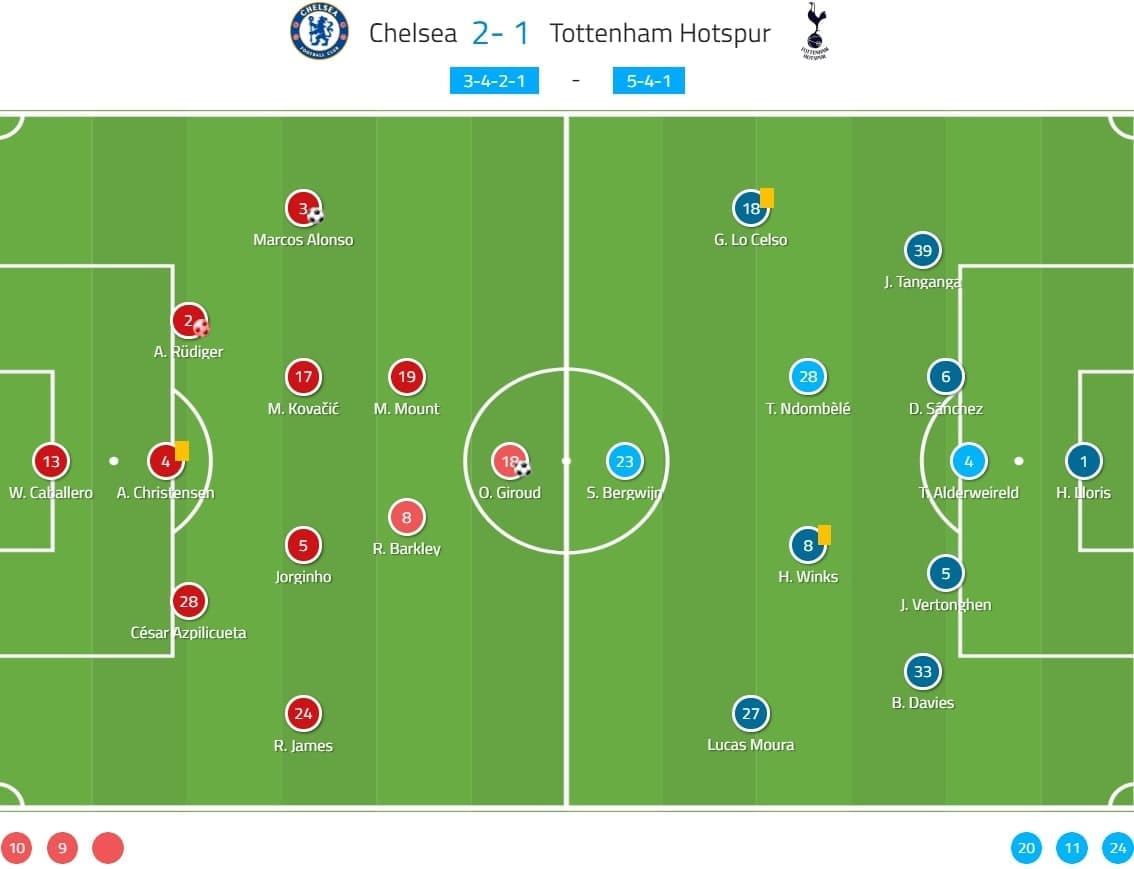
Tottenham’s press
Tottenham did not press high in this game; they formed a midblock to resist the build-up of Chelsea. In general, their defence was separated into two groups of players. The back three stayed deep with the wing-backs and maintained a compact shape. For the other five, they were tasked to press and form the first line of defence.
On most occasions, they formed a ‘pentagon shape’. On paper, they could have man-marked the central players of Chelsea, with both wingers stepping ahead (Lucas Moura – César Azpilicueta; Bergwijn – Andreas Christensen; Giovani Lo Celso – Rüdiger; Ndombélé & Winks – Jorginho & Mateo Kovačić). Ideally, this could prevent central penetration and build-up play.
As shown in this image, Tottenham pressed the front five. Rüdiger received the ball which triggered the press of Lo Celso. Under direct pressure, the German could not progress the ball and returned it to Christensen. When the ball moved, it triggered another wave of the press.
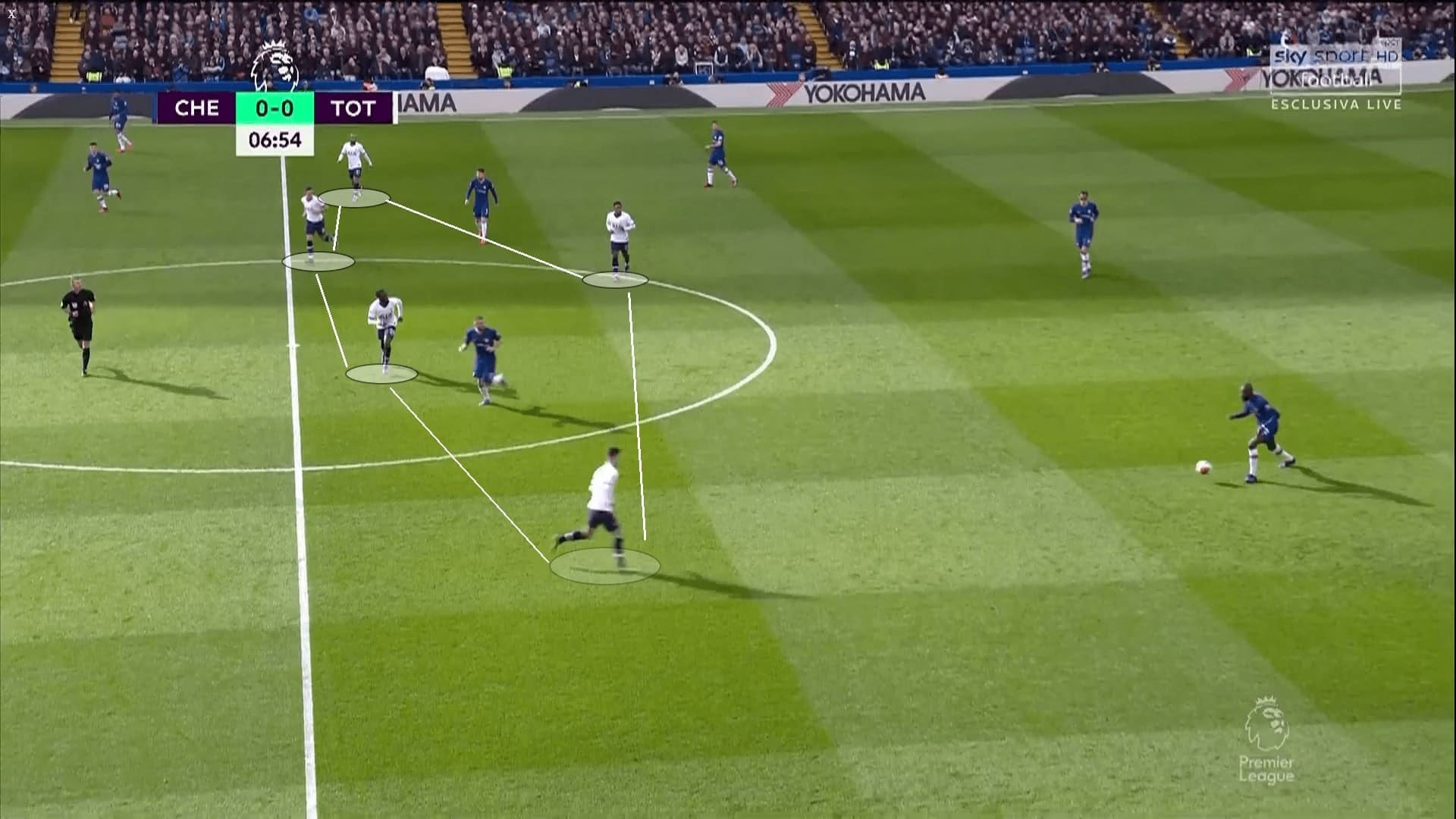
When Chelsea played the ball to the wing-backs, Tottenham had the chance to close the flanks and win the ball. However, the defence was poor on the right, which was a section we are going to explain; by contrast, the partnership of Ben Davies and Jan Vertonghen was a lot better than the other side. Therefore, Chelsea found it difficult to develop the attack through Reece James.
As shown in this scene, since both Vertonghen and Davies stepped up together, they closed down Mount and James simultaneously. Therefore, it prevented an easy central pass from Chelsea’s right wing-back to the attacking midfielder. With the concerted efforts of Moura and Ndombélé to compress space, James returned the ball.
If James took the risks to carry the ball, he might lose the ball under pressure. The right wing-back lost the ball 10 times in the opposition’s half; only Mount, with 12 had more than him among the blue shirts.
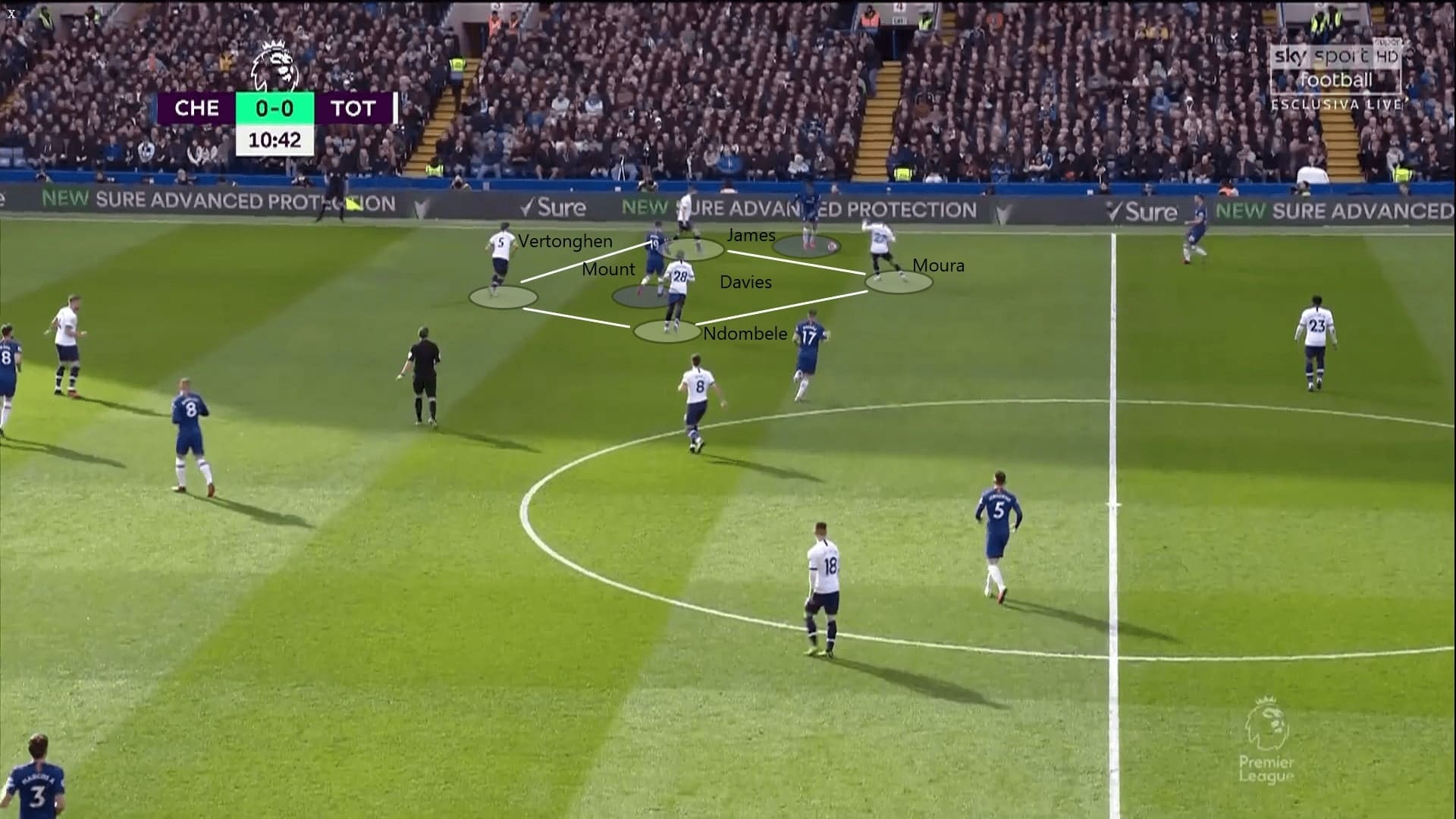
Chelsea overloaded the centre
The 3-4-2-1 formation created some good circumstances for Chelsea’s attack. With a pair of pivots and a pair of attacking midfielders, the Blues successfully dominated the midfield by an overload. In theory, Tottenham only had two players: Ndombélé and Winks in the midfield, hence, Chelsea had a 4 v 2 numerical advantage. It was outlined with the rectangle in the following image.
This created a dilemma for Tottenham’s midfielders. If they stepped up and marked Chelsea’s pivots tightly, then Mount and Barkley enjoyed free space behind them. Also, it became a 3 v 3 against their centre-backs. For the front three of Tottenham, they confronted the Chelsea centre-backs early, so they were unable to defend the Blues’ pivots with the midfielders.
For Mount and Barkley, they enjoyed the freedom to either drop to support the pivots or run between the defenders. Since the Tottenham midfielders mainly focused on Kovačić and Jorginho, the attacking midfielders of Chelsea were threatening in the final third.
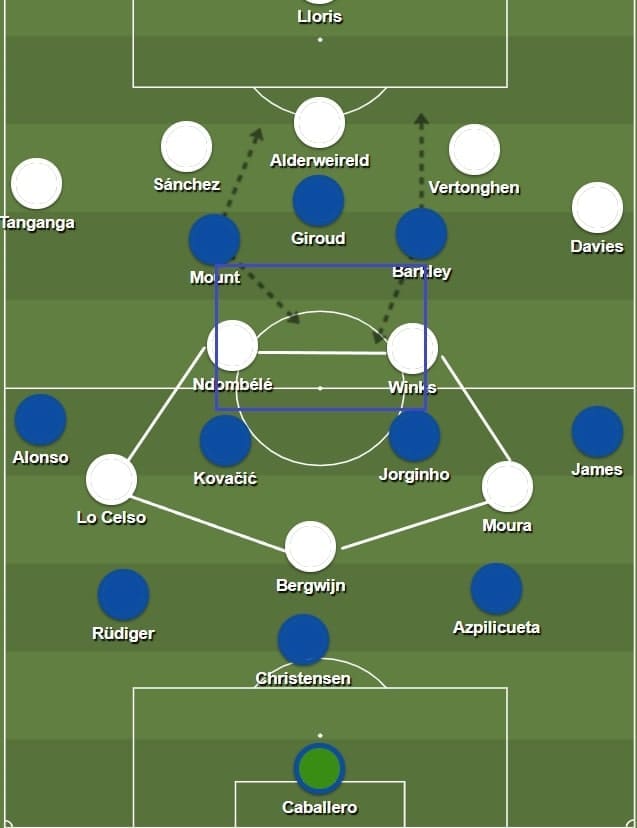
This was a game situation of Chelsea’s boxed midfield. Lampard must be pleased to have two midfielders who could play the ball out under pressure. Therefore, the press from Tottenham’s midfielders was not troubling at all.
As shown in this image, since Kovačić and Jorginho invited the pressure from Ndombélé and Winks, Barkley and Mount were totally free between the lines. Even under pressure, the former Napoli man still penetrated between the lines and found Barkley diagonally. Given the spaces around Barkley, he could turn and shoot.
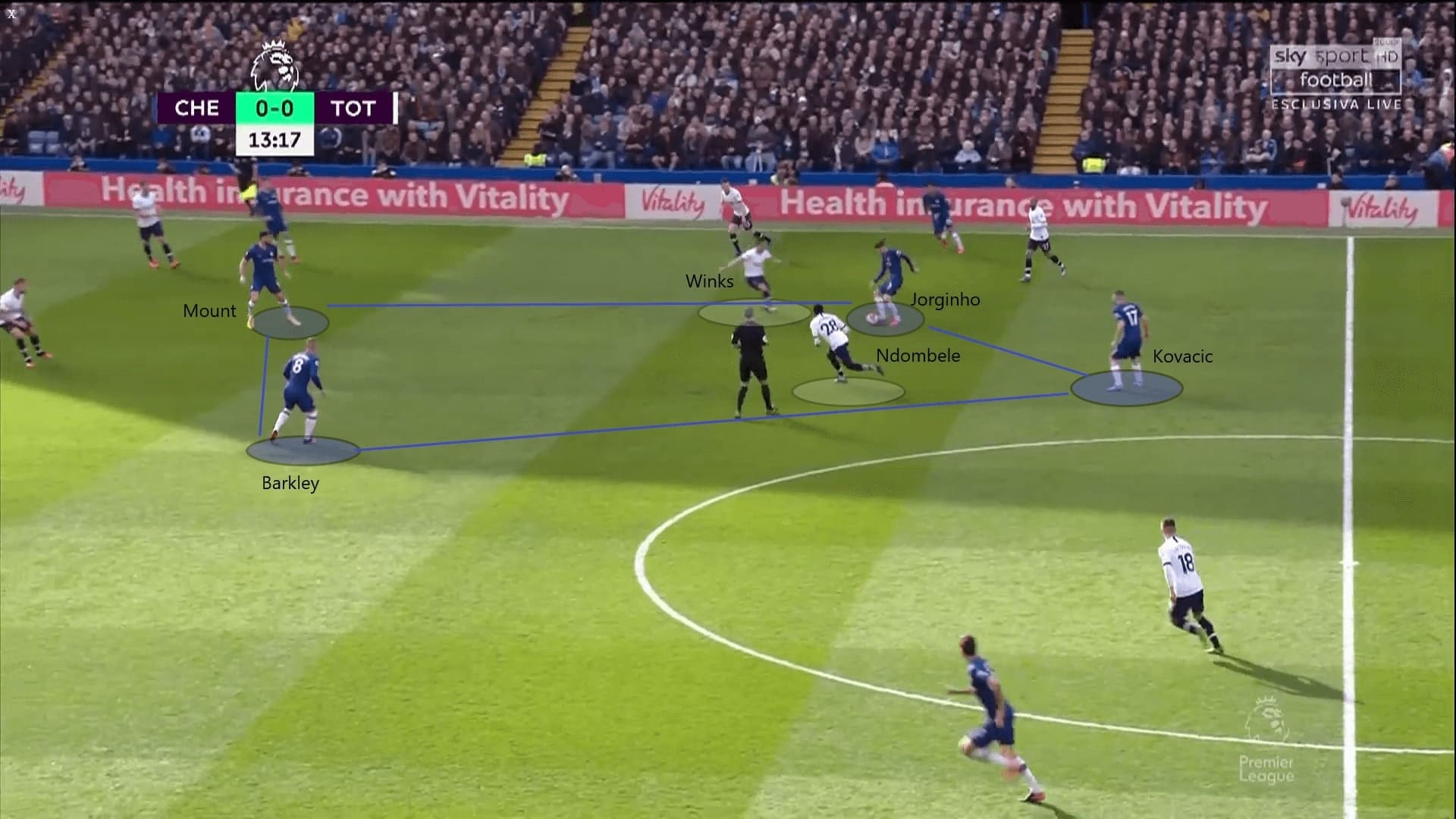
This approach also helped Chelsea to score their first goal. From midfield, Chelsea had Jorginho to deliver a vertical pass. This time, the condition was even better as Tottenham’s defenders tried to mark the Blues tightly. A simple reverse movement by Mount, and Giroud could capitalize on the spaces between defenders.
In this game, both Jorginho and Kovačić recorded impressive stats on their forward passes. Their completion rates were 89% and 92% respectively, from 18 and 24 forward passes. Despite being under pressure from Winks, the Italian still found Giroud with a penetrating pass.
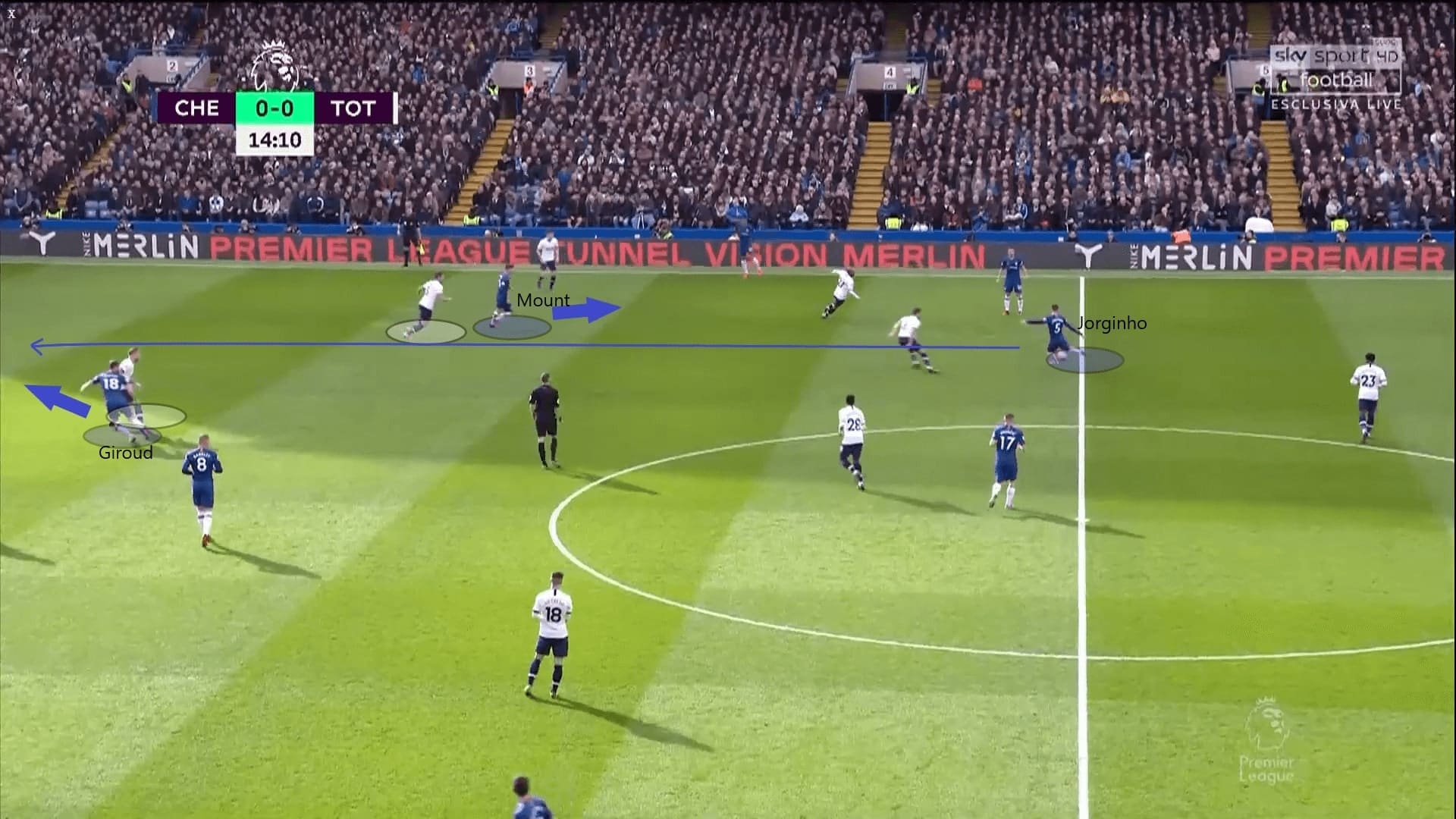
On the flanks, Chelsea also capitalized on Tottenham’s structural issues in their press. The away team had 84 recoveries in this game, but only five per cent of them occurred in Chelsea’s third. As explained, Mourinho’s men did fairly well on their left flank. However, they failed to eliminate the involvement of Alonso.
As explained, Tottenham approached the Chelsea central players without any spare players left. This means they had to use the wing-backs to approach the wing-backs. In other words, the presence of Chelsea’s pivots in their build-up phase was a bait to invite pressure and open the flanks as well. Tanganga was reluctant to step out early and mark Alonso. Therefore, Chelsea were comfortably able to progress down this side.
The passing link of Rüdiger and Alonso was strong. These two exchanged 28 passes; only the combination of Jorginho and Kovačić had more among the Blues (33). As shown in this image, Lo Celso usually failed to close the wide player when he pressed the German, so Alonso became an outlet for the attack. When Tanganga stepped out, this increased the horizontal space between Tottenham’s defenders. Also, since the Chelsea pivots pinned Tottenham’s midfielders, Alonso did not need to play the ball to the pivots. Better than that, he could bypass the midfield and reach the front three, who stayed between the lines.
Alonso could find either one of the front three, and given the close distances between these three, they could combine with each other quickly and further progress the attack.
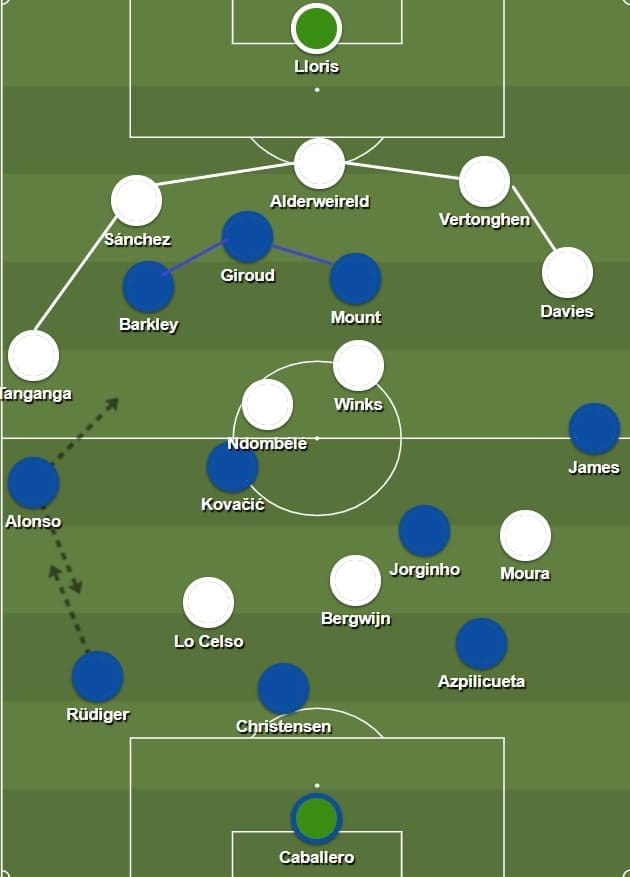
Below is a game example. Alonso had time to adjust the angle of the ball and his body orientation because of the loose marking of Tanganga. Although Winks marked Jorginho, Chelsea still had a free player, Mount, to run diagonally between the defenders. In this case, Alonso found Mount with a wicked curveball and Chelsea entered the box.
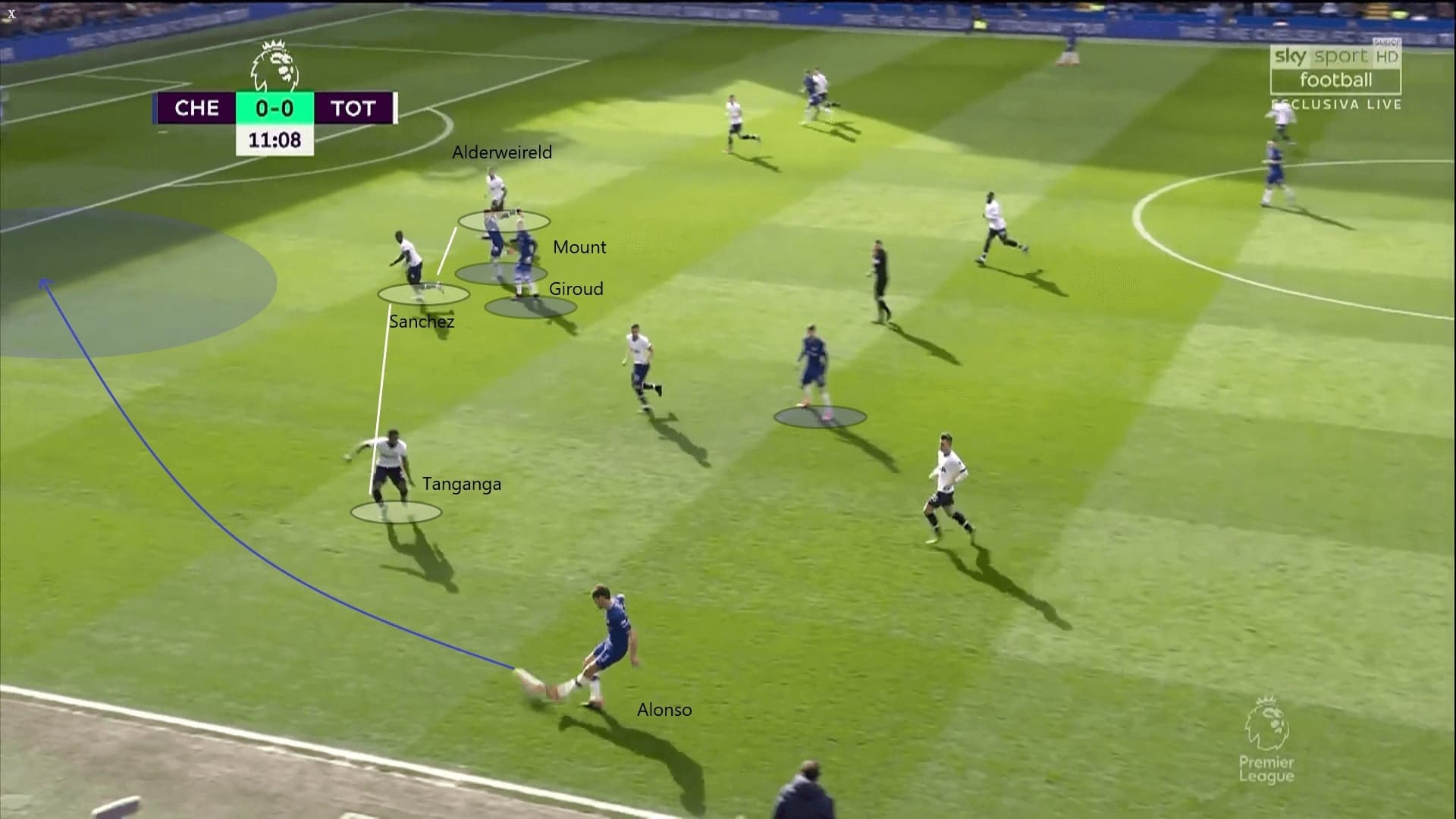
Chelsea’s defensive style of play
Defensively, Chelsea also outplayed Tottenham. They restricted the opponents’ xG to 0.31 and five shots. Among those shots, only one of them came from positional plays. This reflected the success of Chelsea press.
Lampard abandoned the man-marking approach which was used in the last game. In this game, his front players worked closely to close down the ball side. As this image shows, the Chelsea players did a remarkable job in terms of shutting down the midfielders. When Toby Alderweireld had the ball, they allowed the Belgian to find the wide centre-backs. Once this situation happened, they shut the passing lanes to midfielders and to Alderweireld, as well as the wing-backs.
Another benefit of their pressing shape was the release of Jorginho. When playing as a sole pivot, the weak defensive ability of the Italian would be exposed if he was positioned too high. When playing as one of two pivots, he had Kovačić as backup. This prevented the opponents from utilizing spaces between the lines.
For the centre-backs, they were tasked to step up early to engage the Tottenham front players as soon as possible. They had to prevent the opposition from turning and facing the goal. They did a great job in terms of duels and challenges, particularly Rüdiger. The success rates of defensive duels from the centre-backs were 69%, 85% and 75% respectively, from 13, 13 and 4 duels.
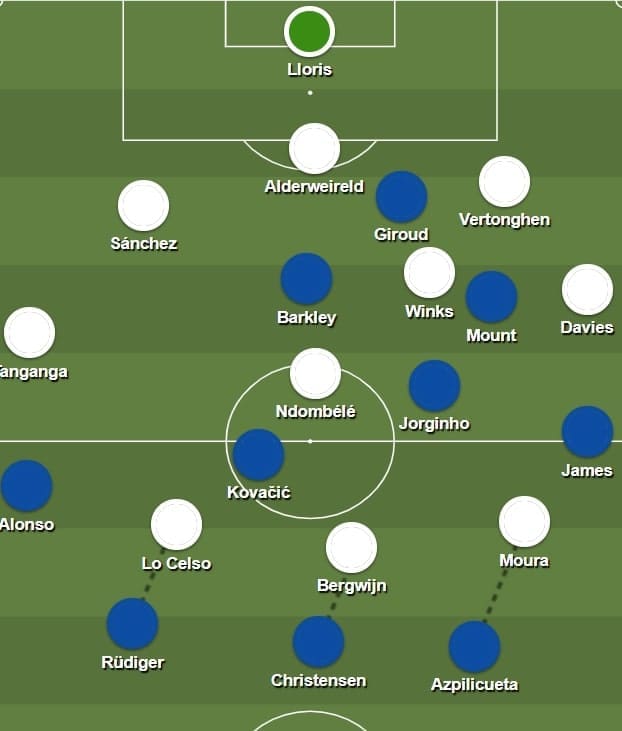
Kovačić played well at both ends. Statistically, he completed 69 passes out of 71 (98%); three dribbles (100%); 10 recoveries (six in the opponents’ half); four interceptions, and five defensive duels out of seven (71%).
Below is the heat map of Kovačić in this game. You could see that the Croatian usually appeared around the central third and the left half-spaces. This could be a result of his role in the build-up plays as explained. Also, defensively, he stayed deeper to cover the spaces behind Jorginho when needed.
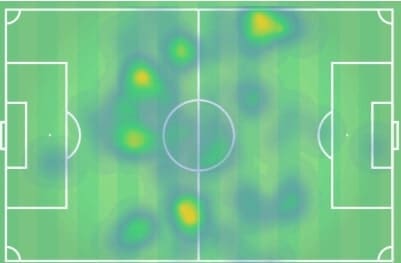
This was an example. As we all know, Jorginho had the intelligence to defend but he lacked physicality. In this case, Ndombélé went past the Italian with his physical superiority, as he won the duel to carry the ball forward.
This was not a problem due to Kovačić’s presence. He moved to the spaces behind Jorginho to recover the ball from the Frenchman.
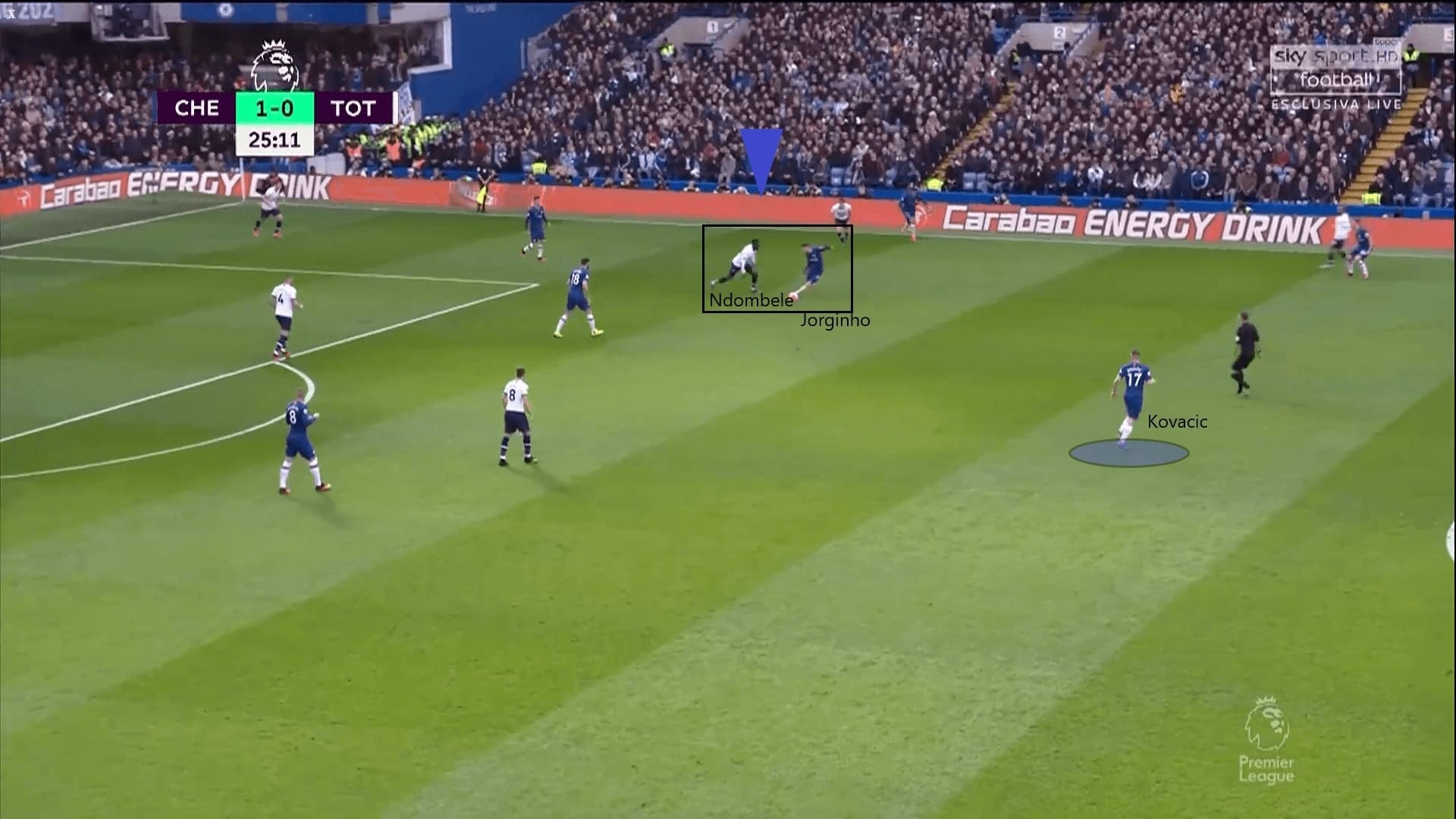
Tottenham had 20 positional attacks in this game, but none of them resulted in a shot. Chelsea’s press disrupted the build-up of Tottenham. As mentioned, they closed the flank and committed numbers to those areas. As reflected in this image, Alonso, Jorginho, Mount and even Rüdiger were involved in the build-up. They were marking Mourinho’s men tightly.
Under pressure, Tanganga could not find a lateral or a forward option, he could merely return the ball to Davinson Sánchez. However, the Colombian was uncomfortable on the ball. Although Ndombélé was a good option to pass to as he was free, Sánchez could not exploit the gap between Giroud and Mount given his poor first touch. As a result, he passed it back to Hugo Lloris.
Tottenham were forced to play long as a result of a lack of options. However, as mentioned, they were not winning the duels with the Chelsea centre-backs.
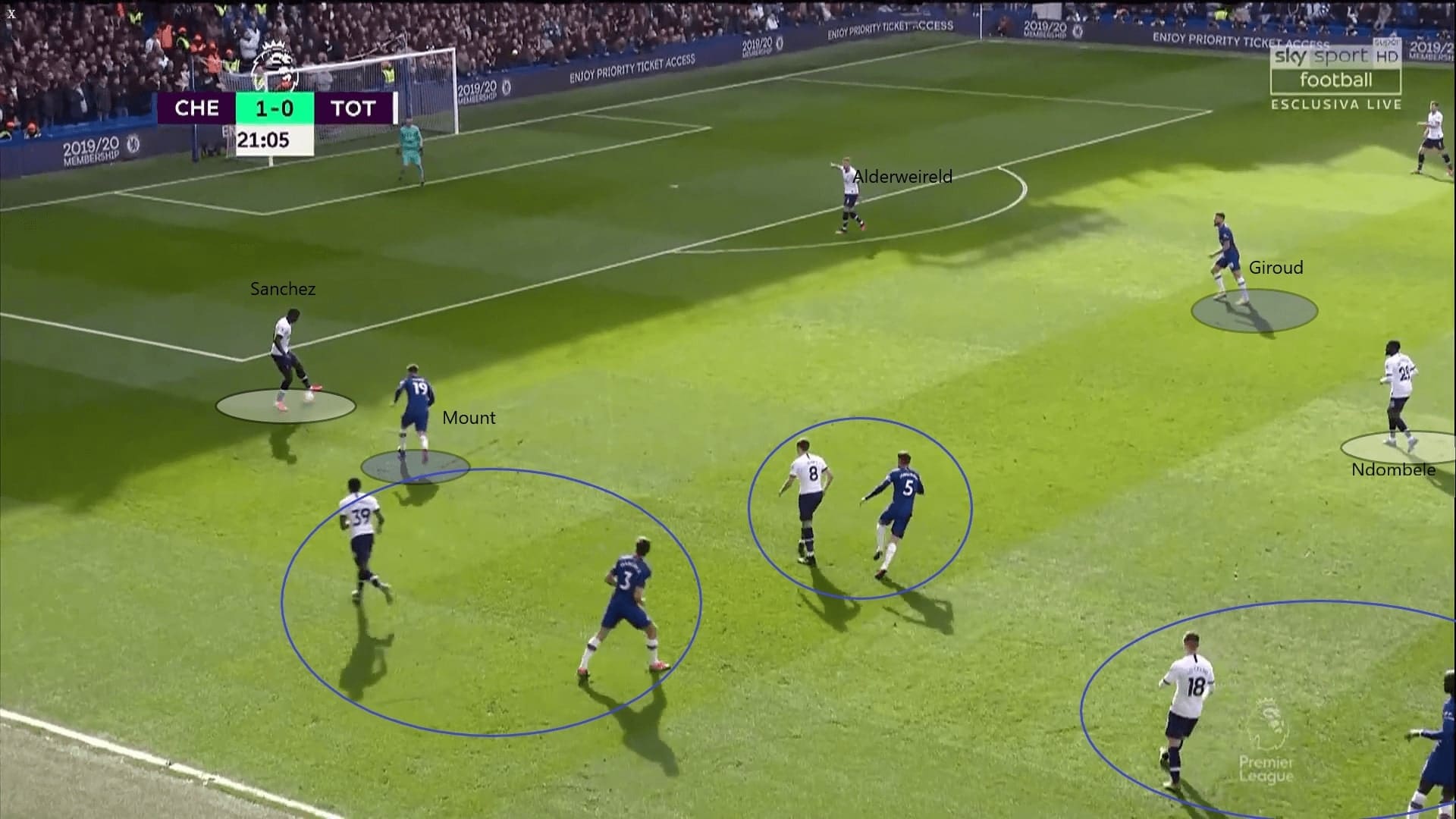
Tottenham’s attacks lacked width
To further explain the inefficacy in Tottenham’s attack, we picked the biggest issue: lack of width. The positioning of Tanganga and Davies was conservative. When the wingers of Tottenham tucked inside, they could only play through the centre. This usually failed as the front three (Moura + Bergwijn + Lo Celso) did not know each other well.
In this example, Tottenham recovered the ball high. However, they lacked Davies’ presence on the left flank. So, Moura’s only option was to pass to the centre, which was easily predicted by the defenders. Also, the execution of first touches and passes of the Tottenham players in the final third was below par. In this case, the Brazilian could not pass the ball on the ground and it was too difficult for Bergwijn to control.
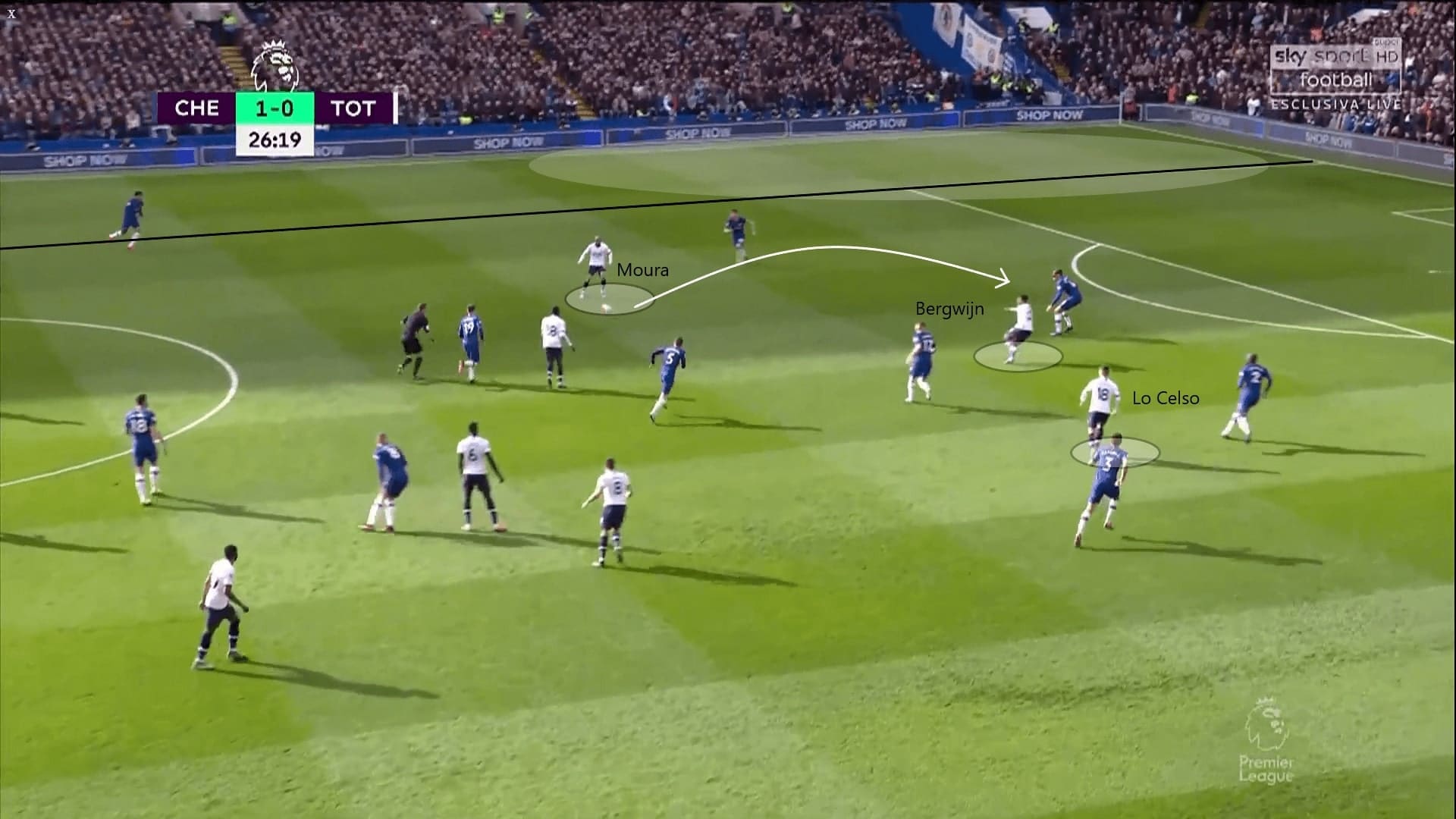
This was another example. Also, it occurred in an offensive transition. When Erik Lamela tried to release a teammate, he only had Moura as an option. There was no sign of Davies on the left flank. Therefore, even though James stayed at the centre of the pitch, the wide areas remained safe as no Tottenham players were exploiting those areas.
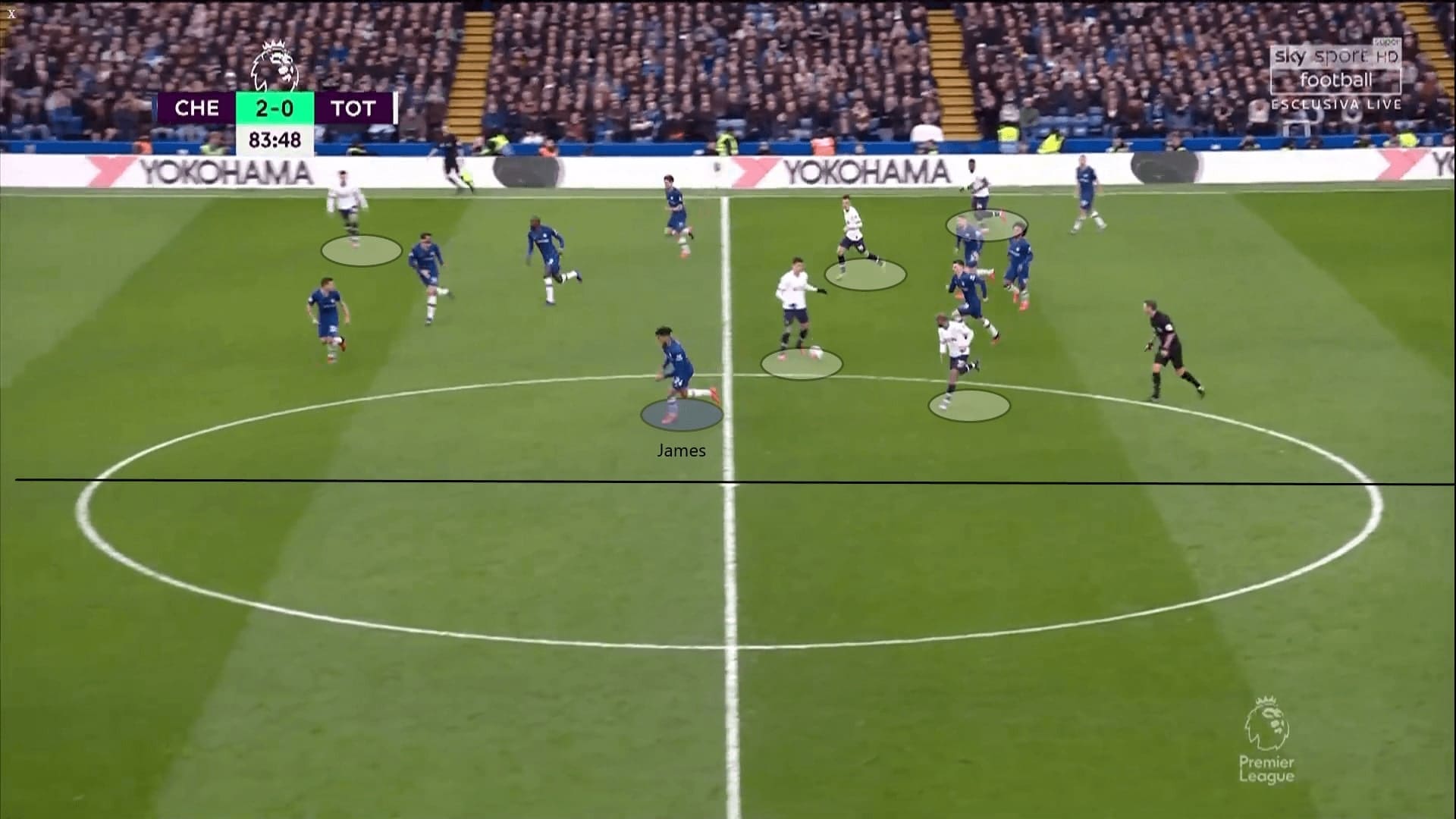
The lacked linkage of Tottenham front three was eased by the introduction of Lamela. The Argentine replaced Ndombélé, with Lo Celso dropping into midfield to partner Winks. The former Roma winger served as a free player to drop between the lines and link plays. He completed 23 passes out of 27 in 32 minutes. As shown in this image, he appeared in the half-spaces, forming a passing triangle with Lo Celso and Tanganga and allowed Tottenham to keep the ball.
However, as mentioned, the issue remained the same. Tottenham’s attacks lacked width which allowed Chelsea to defend easily.
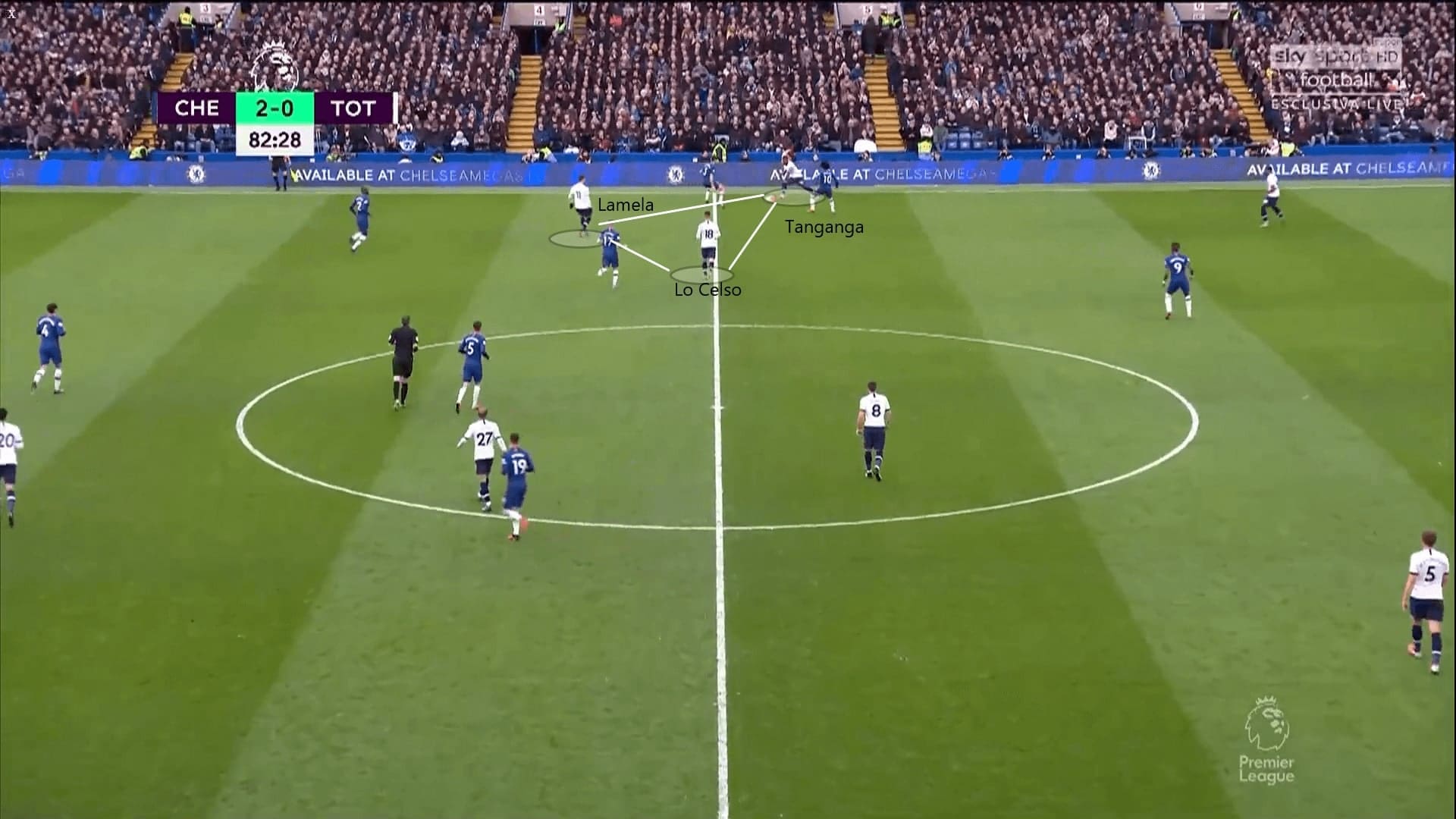
Conclusion
To conclude, it was an important victory for Chelsea. The tactical adjustments of Lampard were appropriate and effective, hence, the young manager should be credited for this victory. The decision to play Giroud instead of Batshuayi was vital, with the Frenchman utilizing his experiences and scoring a goal.
It was unfortunate for Mourinho as he lost both Son and Kane. The current squad does not match the ability of the Chelsea players. They were outplayed in this game, despite the margin of defeat being only one goal. Defensively, the defenders lacked protection from midfielders; offensively, they did not have a clear form of attack. There is a long way for the Portuguese and his team to go.




Comments